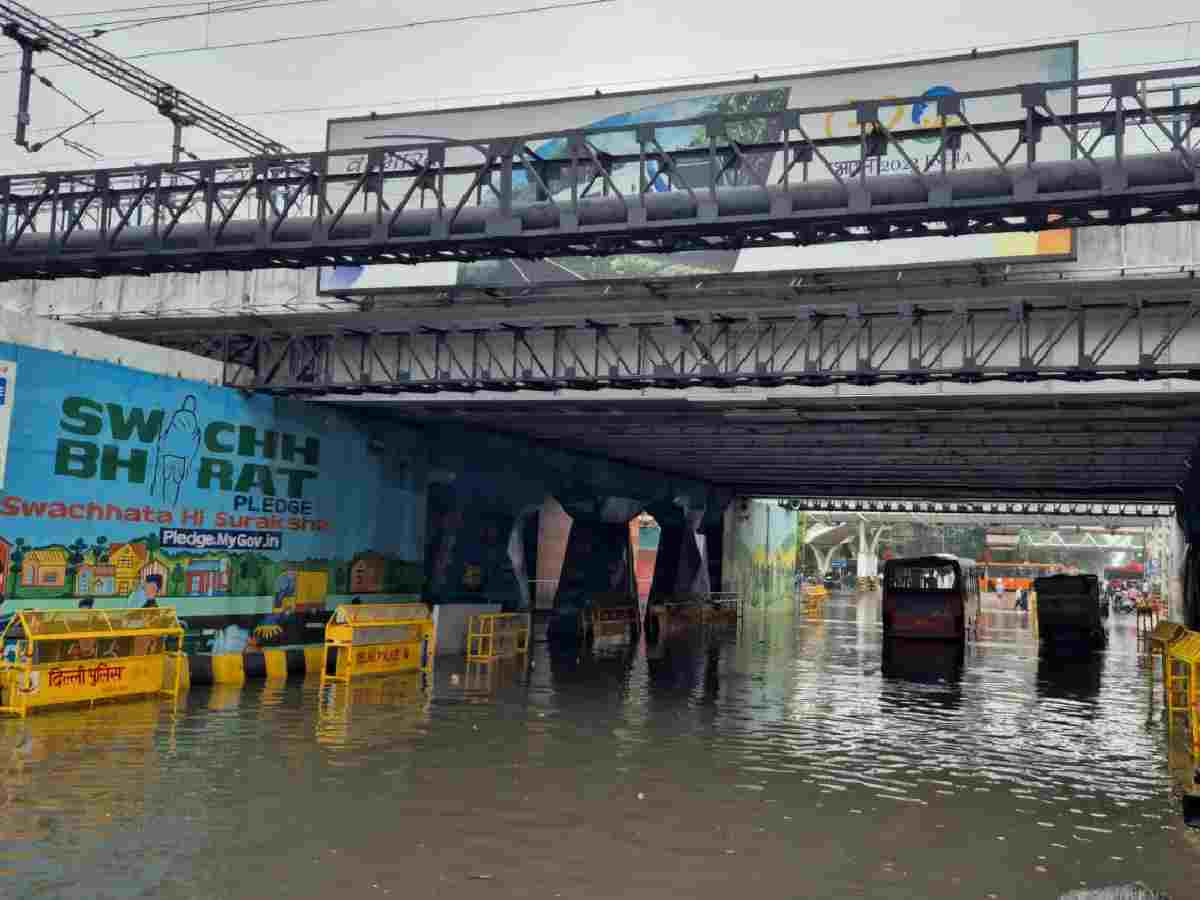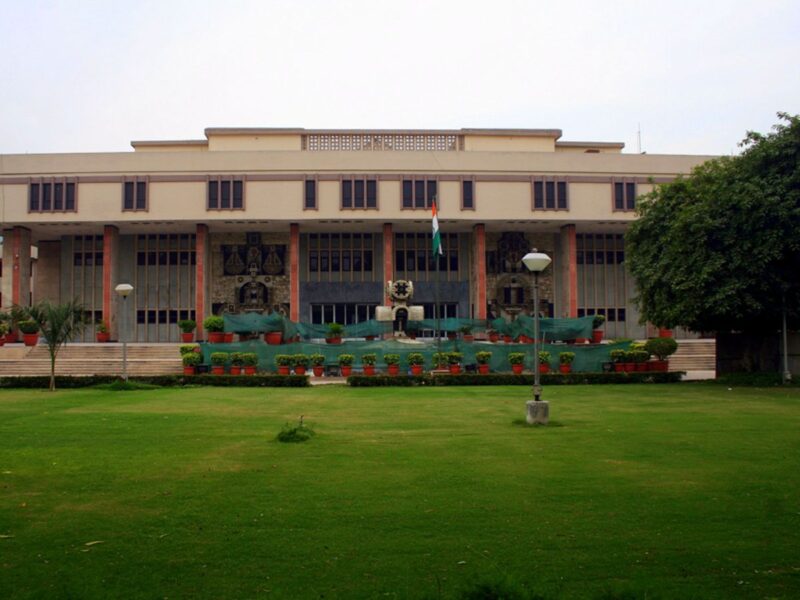Delhi Rains: The monsoon has finally arrived in Delhi after a prolonged and severe heat spell, the Indian Meteorological Department (IMD) announced on Friday.
In an official statement, the IMD confirmed that the Southwest Monsoon has advanced into the Delhi region.
“The Northern Limit of Monsoon passes through 26 °N/65 °E, Jaisalmer, Churu, Bhiwani, Delhi, Aligarh, Kanpur, Ghazipur, Gonda, Kheri, Moradabad, Dehradun, Una, Pathankot, Jammu, 33 °N/74 °E,” the statement reads.
The monsoon’s first rainfall began in the early hours of Friday, lashing several parts of the national capital and causing waterlogging and traffic jams in many areas. The Safdarjung weather station recorded 153.7 mm of rainfall, which began around 3 am.
Traffic Alert
Traffic is affected on Ring Road in both the carriageways from Naraina towards Moti Bagh and vice-versa due to waterlogging under Dhaula Kuan Flyover. Kindly plan your journey accordingly. pic.twitter.com/Y8X1bOXUcE— Delhi Traffic Police (@dtptraffic) June 28, 2024
Data shows that Delhi received monsoon on June 26 last year, June 30 in 2022, July 13 in 2021, and June 25 in 2020.
Significant disruptions occurred on Friday morning. A canopy at Terminal 1 of Delhi airport collapsed, killing one person and injuring others. Water entered homes, submerged vehicles, and led to miles-long traffic snarls. Flight operations at Terminal 1 were suspended till further notice, stranding thousands of commuters.
Traffic Alert
Traffic is affected on MB road in both the carriageways from Hamdard T-Point towards Dr. Karni Singh Shooting Range T- Point and vice-versa due to waterlogging in front of Tughlakabad Fort. Kindly plan your journey accordingly. pic.twitter.com/JCMadsF9lK— Delhi Traffic Police (@dtptraffic) June 28, 2024
Key tunnels, including the one at Pragati Maidan, were closed, and reports of flooding came in from upscale areas like Hauz Khas, South Extension, and Mayur Vihar.
Traffic Alert
Movement of traffic is restricted at Pragati Maidan tunnel due to waterlogging till further notice. Commuters are advised to plan their journey accordingly. pic.twitter.com/mVhC2u3gzc— Delhi Traffic Police (@dtptraffic) June 28, 2024
According to IMD, 228.1 mm of rainfall was recorded at Safdarjung, 192.8 mm at Lodhi Road, 150.4 mm at Ridge, 106.6 mm at Palam, and 66.3 mm at Ayanagar in the last 20 to 30 hours. The IMD defines very heavy rain as rainfall amounting to between 124.5 and 244.4 mm in a day.
The tragic incident at Terminal 1 occurred around 5 am when a canopy at the departure area collapsed, one person died and a few others sustained injuries. The injured were taken to Hospital.
A police official said the deceased was identified as Ramesh Kumar (45), a taxi driver and a resident of Rohini in Delhi.
The injured have been identified as Santosh Kumar Yadav (28), Subham Shah (30), Dashrat Ahirwar (25), Arvind Goswami (34), Sahil Kundan (27) and Yogesh Dhawan (44). They are residents of Delhi, Gujarat and Madhya Pradesh, the official said.
Terminal 1 Incident pic.twitter.com/Dv9Sir5l4p
— Delhi Airport (@DelhiAirport) June 28, 2024
In a statement, Delhi International Airport Ltd (DIAL) said that due to heavy rains and winds through the night in Delhi, a canopy at the old departure forecourt of Terminal 1 (T1) partially collapsed.
“While the cause for the collapse is being assessed, the primary cause seems to be the continued heavy rainfall over the past few hours,” it said in a statement.
According to the statement DIAL has set up a technical committee to investigate the cause of the incident and will give the report as soon as possible.
Also Read: Delhi airport T-1 stops operations after roof collapses, cab driver dead, 6 injured
The Civil Aviation Ministry announced that flights to and from Terminal 1 have been closed till further notice, and alternate arrangements are being made for smooth flight operations.
Inspecting the T1 Terminal and reviewing with the officials.
All required rescue operations are being conducted at the terminal pic.twitter.com/6ck4ce39RY— Ram Mohan Naidu Kinjarapu (@RamMNK) June 28, 2024
Civil Aviation Minister K Rammohan Naidu stated he was personally monitoring the situation.
Personally monitoring the roof collapse incident at T1 Delhi Airport. First responders are working at site. Also advised the airlines to assist all affected passengers at T1. The injured have been evacuated to hospital. Rescue operations are still ongoing.
— Ram Mohan Naidu Kinjarapu (@RamMNK) June 28, 2024
“First responders are working at the site. Also advised the airlines to assist all affected passengers at T1… Rescue operations are still ongoing,” he said on X.
Visited the injured at AIIMS Hospital following the canopy collapse at Delhi Terminal 1. Spoke to doctors and ensured the best treatment is given. My thoughts are with the victims and their families. We are committed to their swift recovery and safety. pic.twitter.com/CnKLydbvyE
— Ram Mohan Naidu Kinjarapu (@RamMNK) June 28, 2024
IndiGo and SpiceJet, which operate domestic flights from T1, confirmed that their operations were impacted.
🚨 Important Update: Due to bad weather (heavy rains), SpiceJet flights have been cancelled as Terminal 1 of Delhi Airport will remain partially closed for operations until further notice. We apologize for the inconvenience and appreciate your understanding. Please contact us at…
— SpiceJet (@flyspicejet) June 28, 2024
IndiGo stated that the unplanned situation had affected operations across its network, while SpiceJet announced that flights have been cancelled as T1 will remain partially closed for operations until further notice.
Several labourers were feared trapped when an under-construction wall in Vasant Vihar collapsed. Rescue operations by NDRF, DDMA, civic agencies, fire, and police are ongoing. Delhi Fire Service (DFS) officials received a call regarding the collapse at 5:30 am and deployed five fire tenders.
Also Read: Delhi Rains: Wall collapses, three labourers feared trapped
Three construction workers are feared trapped in the mud slush, with rescue teams using cranes to remove rubble and pumps to clear water.
The Delhi Traffic Police issued alerts to notify the affected carriageways, advising commuters to plan their journey accordingly. Visuals from various parts of the city showed several areas inundated with water, leading to long traffic jams which affected commuters, especially office-goers.
The Delhi Police received several calls regarding traffic issues, waterlogging, and uprooting of trees since the morning. At the New Delhi Railway Station, people had to walk through knee-deep water, carrying children to navigate the flooded roads. Water also filled metro stations in some areas, adding to commuters’ discomfort.
Traffic is affected on several major roads due to waterlogging, including Anuvrat Marg, Ring Road, Aurobindo Marg, Outer Ring Road, Rohtak Road, Mathura Road, and Road No. 13.
Traffic Alert
Movement of traffic is restricted on both U-turn Tunnels on Mathura Road in front of Pragati Maidan due to waterlogging. Kindly plan your journey accordingly. pic.twitter.com/WIrsPt8W3i— Delhi Traffic Police (@dtptraffic) June 28, 2024
The Delhi Metro Rail Corporation closed the entry and exit gates at Yashobhoomi Sector 25 Dwarka, and the shuttle service from Delhi Aerocity Metro station to Terminal 1-IGI Airport was suspended. Many commuters took to social media to share updates regarding the traffic situation across the national capital.
Lieutenant Governor VK Saxena took stock of the situation in Delhi after hours-long rain brought the city to a standstill and directed officials to set up an emergency control room and deploy static pumps to address waterlogging reports.
Reviewed the water logging/flooding situation in Delhi due to heavy pre-monsson rains, with HoDs concerned at 11:00 AM.
PWD, I&FC & DJB under GNCTD, MCD & NDMC were directed to ensure immediate steps for easing the situation & strictly implement measures to mitigate recurrence.— LG Delhi (@LtGovDelhi) June 28, 2024
Chairing an emergency meeting, the LG said that all senior officers on leave should report back to duty immediately and no leave should be sanctioned for the next two months.
It is shocking that the Flood Control Order & de-silting of drains that should have been issued and completed by 15.06.24, are yet pending.
The Flood Control Order, normally issued after the Apex Committee meeting chaired by Hon’ble CM is pending with the Hon’ble Minister.— LG Delhi (@LtGovDelhi) June 28, 2024
Senior officers of civic agencies, including the Delhi Jal Board, Public Works Department, Municipal Corporation of Delhi, Delhi Development Authority, Irrigation and Flood Control Department, and Delhi Police attended the meeting.
Saxena said that the de-silting of drains had not been completed and the Flood Control Order was yet to be issued.
He directed officials to undertake de-silting work on an emergent basis over the next week and set up an emergency control room for waterlogging complaints, manned 24X7 by senior officials.
Various agencies were instructed to deploy static pumps and field staff to drain water from roads. The Irrigation and Flood Control Department was directed to remain in touch with counterparts in Haryana and Himachal Pradesh to assess rainfall levels and discharges from the Hathnikund barrage.
The revenue department was instructed to activate the disaster response cell under the Delhi Disaster Management Authority (DDMA) in case of excess rainfall and seek assistance from the National Disaster Response Force (NDRF) for any emergency measures during the monsoon.





